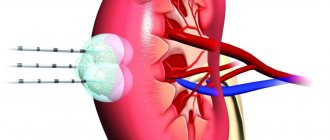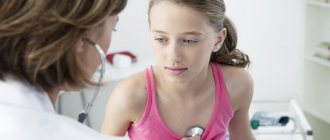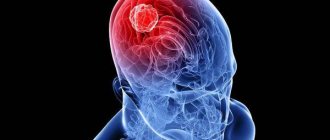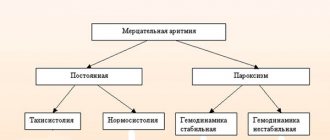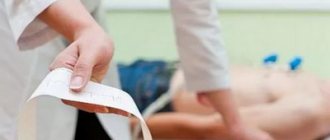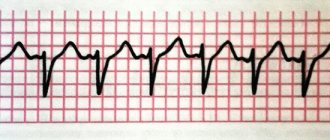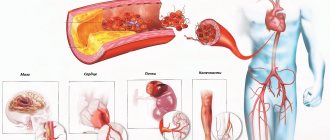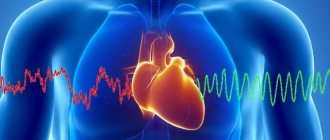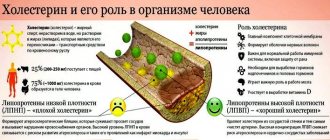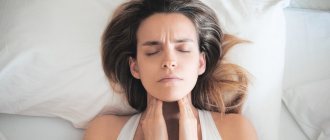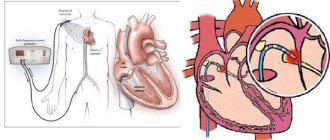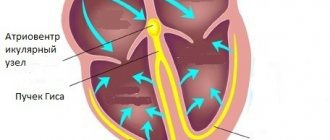Home » Heart disease or cardiac disease » What is arrhythmia, types, symptoms, causes
October 15, 2020 No comments
Our heart has a special node (SU) - the sinus node, which gives the rhythm pulse to the heart muscle. A healthy (normal) heart rhythm is called sinus rhythm. The heart rate (HR), with the correct (sinus) rhythm, is equal to 60 - 90 beats per 1 minute.
Causes
An increase in heart rate throughout the day is a completely natural phenomenon if a person engages in vigorous physical activity, plays sports, or his work activity involves constant movement.
Most people do not attach importance to sudden changes in rhythm and refer to habitual overwork or fatigue as a result of physical activity.
Cardiac arrhythmia has various causes of the disease, including psycho-emotional stress. But pathological deviations are most often provoked by existing diseases (not necessarily related to the heart). Often, the causes of heart arrhythmia lie in an unbalanced diet.
But what causes the disease?
Among the provoking factors that can cause arrhythmia or its prerequisites are:
- increased consumption of coffee or alcohol-containing drinks;
- abuse of tobacco products;
- changes in a person’s psycho-emotional state, frequent stress or attacks of apathy;
- increased physical activity, sports, etc.;
- hormonal disorders;
- metabolic failures;
- heart rhythm disturbance;
- experienced ischemic stroke, cardiac dystrophy, heart disease, sometimes high blood pressure;
- in women, arrhythmia, or its prerequisites, can be provoked by a deviation in the thyroid gland;
- infectious or viral diseases, inflammatory processes in vital organs;
- another reason is menopause;
- abnormalities in the brain.
With the progression of cardiac pathologies, the risk factor for cardiac arrhythmia increases, with the condition that the patient will not undergo timely diagnosis or treatment. The heart weakens and the arrhythmia continues to progress.
Another reason why the disease develops that is worth mentioning is the abuse of drugs, in particular taurine. This drug acts as adrenaline, but has a negative effect on the performance of the heart muscle. As a result, abuse of this medicine leads to atrial fibrillation.
Causes of arrhythmia, incorrect impulse
Basically, the causes of arrhythmia are divided into: causes caused by organic damage to the heart (usually blockades), causes of arrhythmia that appear due to functional disorders of the heart (impaired contraction frequency, extrasystole).
Arrhythmia due to organic causes (damage to the heart muscle) can occur when:
- myocarditis,
- coronary heart disease (CHD),
- heart attack,
- cardiomyopathy,
- developmental defect,
- trauma and heart injury,
- heart failure,
- cardiosclerosis.
Functional arrhythmia occurs as a result of:
- neurogenic influence, these include activation of the autonomic nervous system, exposure to stress and emotions, heavy mental and physical activity, psycho-stimulants (nicotine, alcohol, coffee, tea), neurosis, as well as nutrition.
- disruption of the exchange of electrolytes needed by the heart (potassium, magnesium, sodium, calcium).
- Iatrogenic interventions caused by diuretics, beta blockers, cardiac glycosides, adrenergic agonists.
- hormonal influence, for example adrenaline and norepinephrine, excess thyroid hormone, ACTH (adrenocorticotropic hormones), cortisol.
- painful condition (fever, intoxication, hypoxia, anemia.
- idiopathic disorders (with unknown causes).
With organic arrhythmia, defects form in the heart muscles; due to damaged nerve branches, they cannot contract correctly. When the pacemaker, the sinus node, is affected, the impulse begins to be generated in the wrong way.
With functional arrhythmia, disturbances in the flow of impulses to the heart muscle occur due to external influences or the heart is unable to correctly understand the signals that are received by it.
(No Ratings Yet)
Symptoms
Irregularities in the heart rhythm can cause different symptoms, since the characteristic symptoms directly depend on the clinical picture and the cause of the disease. For example, one of the symptoms of arrhythmia is tachycardia (increased number of heartbeats).
The disease, called arrhythmia, is often asymptomatic. Based on medical practice, patients complain of noticeable heartbeats, a sudden feeling of restlessness, increased sweating, partial loss of coordination of movements, and lack of full-fledged mental activity.
With the opposite phenomenon, bradycardia, a slowdown in heart rate occurs. Among the characteristic symptoms, acute pain that occurs in the chest area, sometimes felt in the gastrointestinal tract, migraines, malaise, pallor on the face (anemia), and a state close to fainting are especially prominent.
During vigorous physical activity, the patient may suddenly faint or lose coordination in space.
Extrasystole is the most common manifestation of arrhythmia, characterized by cardiac changes. With this pathology, heart contractions occur a few seconds before the scheduled time. The patient feels light (strong) tremors in the chest, sometimes it feels like there is no heartbeat at all. These symptoms appear during the day, but are especially noticeable closer to night.
The duration of the extrasystole is from 10 to 50 seconds, after which the heart rhythm resumes, and the sick person can continue the same vigorous activity or physical activity.
The most striking sign indicating the presence of extrasystole is a sudden feeling of fear of death, accompanied by profuse sweating, which occurs at a moment of severe fatigue or moral distress.
An extreme type of serious pathology, which is a serious cardiac abnormality, is considered to be atrial fibrillation. Its characteristic signs are: malaise, frequent drowsiness, and the main criterion is over 140 beats per minute.
The patient experiences a sharp lack of oxygen, a feeling of panic, and a pre-fainting state. Symptoms appear in this order.
If cardiac arrhythmia is accompanied by convulsions in the lower extremities or chest, there are no stable beats when measuring the pulse and the patient often loses consciousness, this indicates heart block, which is dangerous because it can be fatal.
If the above symptoms occur, it is recommended to immediately visit a medical facility for diagnosis and treatment of arrhythmia and its symptoms.
What is cardiac arrhythmia? Rhythm failure.
All rhythm disturbances (arrhythmia) are unhealthy (non-sinus) rhythms, with an increased heart rate (heart rate more than 90 beats per minute) or a low rate (less than 60 beats per minute). In other words, any deviations from the normal rhythm are called arrhythmia. As I have already said, we call the correct heart rhythm sinus, in which the heart pulsates with a stable rhythm of 60-90 beats per minute. If the heartbeat is more than 100 beats per minute. – this is a disorder and is called tachycardia (rapid heartbeat). The heartbeat is rare, approximately 55 vibrations per minute. – this disorder is called bradycardia (rare heartbeat). In small children, the heart rate is not 60–90 beats per minute. as in an adult, but 140 or more, since in children, 140 beats per minute is normal.
Diagnosis of arrhythmia
Visual examination and a number of laboratory tests cannot show arrhythmia and its signs (with the exception of measuring blood pressure and pulse). Diagnostics consists of hardware and instrumental examination, namely fluoroscopy and cardiogram. The causes and treatment of the disease are closely interrelated.
Based on the results obtained, the doctor diagnoses a form of arrhythmia (tachycardia, bradycardia, etc.). It may also be that a series of laboratory tests are required if the disease develops as a result of an acute infectious lesion.
It is important to remember: Therapy is prescribed only by the attending physician. Self-treatment and the use of heart medications entail serious consequences, including weakening the tone of the circulatory organ, which threatens to be fatal.
If arrhythmia occurs during acute heart failure, it is necessary to carry out complex treatment, since the risk of death is too great. Traditional medicine methods are prohibited.
How to properly treat various types of arrhythmia at home?
In addition to taking medications, you can try to treat arrhythmia with folk remedies. You can use recipes such as:
- lemon tincture;
- calendula decoction;
- herbal infusion;
- hawthorn drink.
Lemon tincture has a therapeutic effect for arrhythmia
To prepare lemon tincture, you need to take half a kilogram of these fruits, rinse them under water and finely chop them, then pour in 500 g of liquid honey. The components are thoroughly mixed together, and 20 almonds are added. The resulting composition must be infused for five hours, after which it can be consumed one tablespoon in the morning and evening.
A decoction of calendula gives a good result for arrhythmia. To prepare it, you will need a tablespoon of the flowers of this plant, which is poured with two glasses of boiling water. The container is closed with a lid, covered with a towel and left in this state for one hour. After this, the decoction is filtered and taken three times a day, 120 ml, 20 minutes before meals. The duration of therapy is two weeks.
You can treat cardiac arrhythmia at home with the help of herbal infusion, which is prepared from pharmaceutical tinctures of motherwort, valerian and hawthorn. All components are taken in equal proportions, mixed and poured into a dark bottle. The resulting medicine is taken daily in the morning, 5 ml for one week. It's better to do this before breakfast.
Hawthorn will help defeat arrhythmia in familiar, home conditions. It normalizes the rhythm of contractions, stimulates the work of the heart muscle, accelerates blood circulation and copes well with tachycardia. In addition, a drink made from hawthorn calms the excited nervous system. It is prepared quite simply.
Treatment of cardiac arrhythmia at home involves taking pharmaceutical medications prescribed by your doctor. Such therapy is purely individual and should be focused primarily on eliminating the cause that provoked the disturbance in the frequency and rhythm of myocardial contractions. In addition to medications, there are many recipes for traditional and alternative medicine that can support the body and restore the normal functioning of the cardiovascular system. In the treatment of arrhythmia, the following have proven themselves to be the best:
- Peppermint. It is one of the most effective and affordable herbal remedies that supports the heart muscle and has a pronounced sedative effect. A teaspoon of dried leaves is poured into a glass of boiling water and infused for an hour and a half. It is necessary to drink such an infusion in case of fading and interruptions in the functioning of the heart (atrial fibrillation) every day shortly before breakfast.
- Kalina. It has long been used in the treatment of various ailments and pathologies of the cardiovascular system. Increases the body's defenses, normalizes blood pressure and can be consumed both dried and fresh. Most often, the berries are ground with sugar using a sieve, which allows you to preserve most of the microelements and vitamins. Viburnum has the ability to lower blood pressure. It should be used for paroxysmal and other types of tachycardia, accompanied by rapid heartbeat.
- Adonis increases contractile function, but reduces the excitability of the heart muscle and slows down the frequency of contractions. It is used primarily for extrasystole provoked by VSD. 8 grams of dried, finely chopped parts of the plant are poured into 0.5 liters of hot water and simmered over low heat for no more than 3-4 minutes. After the resulting mixture has infused properly, it is necessary to strain it and take it several times a day in an amount of 20-25 ml. Positive changes in the functioning of the cardiovascular system are observed after just a week of regular use of Adonis decoction.
DETAILS: Scleroderma: what is it and how to treat? Causes, symptoms and signs of scleroderma
Hawthorn in the form of fresh fruits or alcohol tincture has a positive effect on the treatment of tachycardia at home. To prepare it, several dozen berries are finely ground together with the seeds, after which 250 ml of boiling water is poured. The resulting liquid is divided into 4-5 servings, which are drunk throughout the day.
Dried figs are a good remedy for increased heart rate. In order to prevent chronic tachycardia, you can drink half a glass of beet juice daily, to which a spoonful of natural honey is added. You need to take this remedy three times a day before each meal. How to relieve arrhythmia at home?
When treating arrhythmia, traditional medicine recipes will come to the rescue. It should be understood that herbal treatment does not replace the need to visit a doctor and follow his recommendations in full.
- In case of cardiac arrhythmia, it is useful to prepare an infusion of cornflower flowers for treatment. A couple of tsp. Brew flowers with a glass of boiling water, leave, strain. Take ¼ cup 3 times a day ten minutes before meals.
- Pour 1 tbsp. motherwort herbs with a glass of water at room temperature, leave for 8 hours. Take throughout the day.
- Brew 1 tsp. motherwort with a glass of boiling water, leave for 2 hours. Take a glass half an hour before meals.
- Blackcurrant juice, consumed one third of a glass three times a day, helps restore and treat heart rhythm.
- Serviceberry berries not only strengthen and normalize the nerve conduction of the heart muscle, but also counteract atherosclerosis, relieve vascular spasm, reduce the risk of blood clots, and thin the blood.
- Grind 1 tsp. strawberry leaves, brew a glass of boiling water, leave for an hour. Take 1 glass before breakfast for two months to treat cardiac arrhythmia, atherosclerosis, hypertension, angina pectoris.
- Infuse 100g of white willow inflorescences in 0.5l of vodka, strain after a month. Take 30 drops before meals for arrhythmia and tachycardia for 30 days, adding a little water.
- Get juice from 2-3 leaves of golden mustache, add 250g of honey, three tbsp. lemon juice. Take the mixture 1 tbsp. twice a day half an hour before meals for 10 days.
- Crush the partitions of the walnuts, fill a glass container, fill it to the top with vodka and leave for two weeks. Take 30 drops of tincture once a day with water to treat arrhythmia, heart pain, shortness of breath.
- 3 tbsp. Wash the viburnum berries and pour 2 liters of boiling water, close the lid and leave overnight. Strain, squeeze out the berries, add 0.5 liters of honey to the infusion. Take 1/3 tbsp. on an empty stomach in the morning and evening. The duration of the course is one month. Store the medicine in the refrigerator. It is recommended to repeat the course after a ten-day break;
- 1 tsp. pour 0.2 liters of boiling water over calendula flowers, leave in a thermos for 2 hours, strain, squeeze out the flowers, bring with boiled water to the original volume. Take ½ tbsp. 3-4 times a day before meals.
- Decoction of hawthorn leaves: 1 tbsp. l. dried leaves, pour 0.5 liters of boiling water, leave for 30 minutes, filter, take 0.2 liters three times a day after meals. Course duration – 4 weeks;
- 2 tbsp. l. Hawthorn berries (dry) are poured into 1 liter of boiling water, simmered over low heat, not allowing them to boil over, for 20 minutes, add a whole glass of dry rose hips, keep on fire for 15 minutes. Cover with a lid, leave the broth for 24 hours, filter, take 2 tbsp on an empty stomach three times a day. l. The finished broth is stored in the refrigerator. The course of treatment is 15 days, after a ten-day break the treatment is repeated.
Recipe 1. Rinse 200g of dried apricots, pour boiling water over them, and pass through a meat grinder. Wash 30g of raisins, chop them together with 50g of peeled walnuts. Get the juice of one lemon, add 100-150g of honey. Mix all ingredients. The remedy for arrhythmia is ready in three hours. Take 2 tbsp. after breakfast for a month.
Recipe 2. Wash 5 lemons, cut, remove seeds, mince. Add 30 crushed apricot kernels, 300 g of honey. Mix thoroughly and wait at room temperature for 8-10 hours. Keep refrigerated. Take 1 tbsp. after breakfast and dinner.
Recipe 3. Mix 100 ml of lemon, carrot, apple juice with 130 ml of orange juice. Take half a glass of the mixture twice a day for two weeks.
Treatment of the disease
Arrhythmia is eliminated through complex treatment. As is known, the primary sources of heart rhythm deviation are chronic diseases of the circulatory organ, including ischemia or arterial hypertension; the patient is prescribed a number of drugs to stimulate full activity.
Among the effective and popular medications that treat arrhythmia and its consequences are:
- Angiotensin-converting enzyme inhibitors (ACE inhibitors). Restore heart rhythm, eliminate arrhythmia and its symptoms. Intended for a long therapeutic course. Drugs belonging to this group are designed for single use. Combination treatment is strictly prohibited;
- Sartans. Stimulant drugs. Eliminate deviations in heart rhythm, used as prophylaxis for ischemia;
- Beta-adrenergic blockers. Potent cardiac drugs that saturate the blood muscle with essential nutrients, including oxygen. Prevent atrial fibrillation. Prescribed for a short course, since long-term use of drugs can lead to serious consequences;
- Diuretics. Intended for prevention if there are abnormalities in the myocardium.
Other drugs for the cardiovascular system are prescribed on an individual basis, if necessary or if there is a risk factor for relapse of the disease. Treatment of arrhythmia of all types must be comprehensive, since the disease has serious consequences. The prescribed drugs, with the exception of angiotensin-converting enzyme inhibitors, are used by the patient for 2-3 weeks.
Unfortunately, it is not always possible to limit yourself to taking medications, so all types of cardiac arrhythmia are treated surgically.
Drug therapy
With arrhythmia, the heart rhythm is disrupted and blood begins to accumulate in certain parts of the heart, thereby increasing the risk of blood clots. Therefore, medications that thin the blood (Warfarin, Aspirin) are among the first to be prescribed. The dosage and frequency of administration will be determined by your doctor.
Also included in the treatment are drugs that have a positive effect on the condition of the heart muscle. One of them is Riboxin, which protects myocardial cells from oxygen starvation and accelerates their regeneration. The cardiologist must prescribe antiarrhythmic drugs:
- Sodium channel blockers.
- calcium channel locators.
- Beta blockers.
Sodium channel blockers reduce the frequency of contractions of the heart muscle and have a strengthening effect on the cell membranes of this organ, reducing their excitability. These include Lidocaine, Propaphenone, Quinidine.
Calcium channel blockers disrupt the transport of ions, which are precisely responsible for accelerated heart contraction. The most commonly prescribed drugs are Diltiazem and Verapamil. Beta blockers significantly reduce heart rate. These are Anaprilin, Concor, Metoprolol, Nebilet. The latter medicine belongs to a group of new generation drugs, due to which it will be enough to take it once a day, and at the same time it will have a prolonged effect.
In addition to the proposed drug therapy, in specific cases, consultation with a pulmonologist, endocrinologist and gynecologist may be required. And these specialists can also prescribe their own list of medications after diagnosis. If severe degradation of the cardiac muscle tissue occurs, then surgical intervention is resorted to.
For bradycardia, treatment will depend on the severity of the disease itself.
Direct surgery
Emergency surgery is a measure intended in critical situations if a person is at risk of losing the tone of the heart muscle or if surgical treatment has failed.
The first method is implantation of a pacemaker. The electronic box, called a pacemaker, is designed for a long service life - up to 12 years (depending on the manufacturer and quality of the device). Once installed, the device sends electrical shocks to trigger cramps in the heart. Thus, the occurrence of arrhythmia is prevented and heart rhythm disturbances are eliminated.
Defibrillator implantation. This device is an analogue of a pacemaker, designed to discharge the myocardium. The only difference is that electrical discharges sent to the myocardium promote the natural regeneration of cardiac fibers, which eliminates irregular contractions and returns a full pulse.
According to statistical data from medical workers, a defibrillator can prolong a patient’s life by 12-15 years, provided that it is installed correctly and the prescribed recommendations are followed. It is strictly prohibited to treat cardiac pathology with an implanted defibrillator using medications.
Another surgical option that emerged in the mid-nineties is radiofrequency ablation. Using RFA, it is possible to stabilize the heart, but it is not possible to exclude atrial fibrillation or heart block.
The method is as follows: using a catheter, the skin is pierced and problem areas on the heart are treated with radio waves.
It is impossible to carry out the procedure without preliminary fluoroscopy and a cardiogram.
After drug or surgical treatment, a series of preventive procedures follows, designed to consolidate the achieved result and to prevent cardiac arrhythmia from developing in the future.
